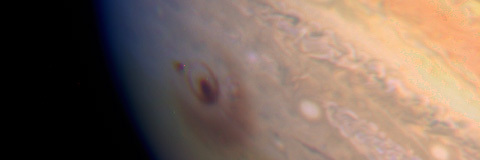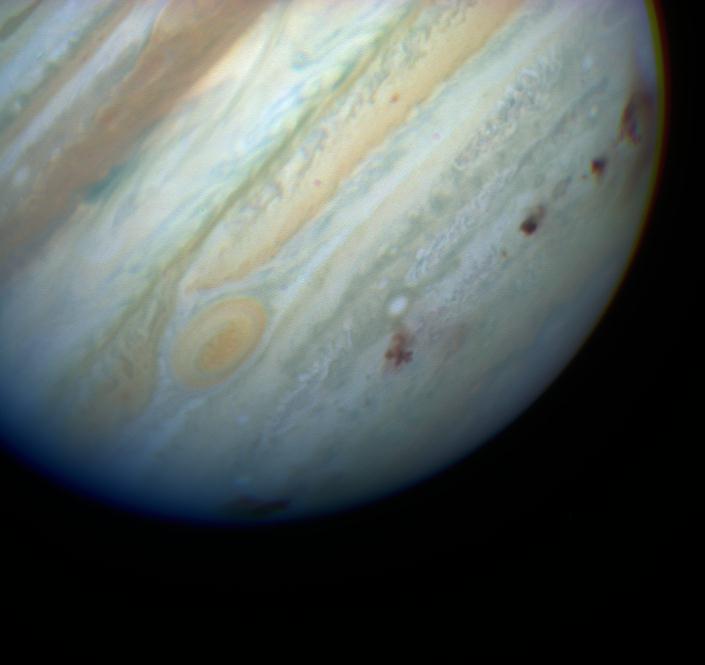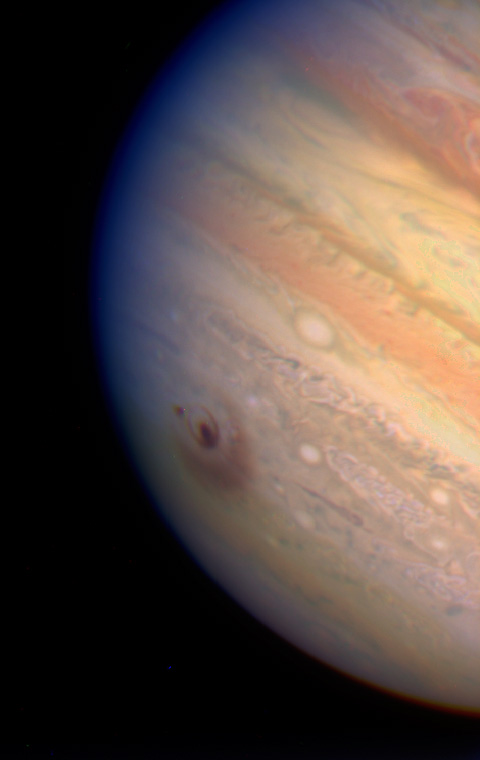In July 1994, we witnessed for the first time ever an extraterrestrial collision in our Solar System in real time, when the comet Shoemaker–Levy 9 collided with Jupiter. This incredible event was followed by many people and extensively covered by the media, while astronomers all over the world studied the collision. Thanks to this impact, scientists were able to discover new information about Jupiter, its role in reducing space debris, and the chemical composition of its atmosphere.
The comet Shoemaker–Levy 9 was discovered on March 24, 1993, by Carolyn Shoemaker, Eugene Shoemaker, and David Levy, three astronomers of the Palomar Observatory in the United States, while they were looking for near-Earth objects. This was the ninth periodical comet discovered by the group, and it was immediately clear that it was an unusual object. The discovery image already showed that it had multiple nuclei, and it appeared to be oddly close to Jupiter.
Indeed, astronomers soon found out that, for the first time ever, they were observing a comet that was orbiting Jupiter, rather than the Sun. While it’s not unusual for Jupiter to capture other objects, the size of comet Shoemaker–Levy 9, which had a diameter of around 1.8 km, made it an anomaly. A study after the impact suggested that objects of this size are captured by Jupiter only once every 6,000 years. Further observations soon after the comet’s discovery revealed that the object had an highly eccentric orbit around the planet, with a period of 2 years, and was likely captured between 20 and 30 years earlier. The fragmentation of the comet likely happened in July 1992, when it had an extremely close approach to Jupiter, reaching a point where the planet’s gravity was strong enough to disrupt the nucleus of the object.
An image of the fragments of comet Shoemaker-Levy 9 taken by the Hubble Space Telescope on May 17, 1994 (NASA, ESA, and H. Weaver and E. Smith (STScI)).
Orbital calculations suggested that, on its next approach with Jupiter, the comet would collide with the planet. This caused a lot of excitement among astronomers, as it was the first time ever that we would witness a collision between Solar System objects in real time. The fragments, which ranged in size between a few hundred meters and over a kilometer, impacted Jupiter one after another between July 16 and July 22, 1994.
The first impact happened on the side of planet hidden from Earth, but was witnessed by space observatories and spacecrafts such as Galileo, which was on its way to Jupiter at the time. The first fragment impacted with Jupiter at 60 km/s, creating a fireball that reached a temperature of almost 24,000 °C and a height of 3,000 km. Over the next six days, there were a total of 21 impacts, with the largest one happening on July 18. Every impact left dark spots on the atmosphere of Jupiter, which were large enough to be visible from Earth. The largest one, a consequence of the collision of July 18, was over 12,000 km in size, meaning that it was almost as large as Earth’s diameter.
Dark spots on Jupiter after the collision of comet Shoemaker-Levy 9 (Hubble Space Telescope Comet Team and NASA).
The impact led to various discoveries about Jupiter. Chemical studies revealed for the first time ever that the atmosphere of the planet had diatomic sulfur (S2) and carbon disulfide (CS2). Meanwhile, astronomers detected much less water than expected, and later studies revealed that the destruction of the fragments happened at much higher altitudes that what was predicted, so the objects didn’t reach the cloud layer that includes water. The collision also caused the spread of waves throughout Jupiter’s atmosphere, which swept across the planet at 450 m/s. Auroral emissions were also observed around the impact sites, as well as at the antipodes of this region, likely due to the interaction between charged particles accelerated by the collision and the planet’s magnetic field.
The dark spots remained visible on Jupiter for months, and were even more prominent than the Great Red Spot. The chemical composition of the atmosphere at the impact sites was also disrupted for more than a year, before returning to normal levels. Instead, the temperature quickly dropped to normal in a few weeks.
The largest of the impact sites on Jupiter after the collision of comet Shoemaker-Levy 9 (H. Hammel, MIT and NASA/ESA).
The impact also revealed the importance of Jupiter in protecting the inner planets from fragments coming from interstellar space and the outer Solar System. Because of its strong gravitational influence, Jupiter attracts many asteroids and comets, and the rate of impacts on Jupiter is thought to be thousands of times higher then the rate on Earth. Without Jupiter, Earth would be struck by asteroids such as the one that led to the extinction of the dinosaurs much more often. This would have catastrophic repercussions on the development of life on our planet, and complex organisms might not have been able to evolve.
On July 19, 2009, exactly 15 years after the collision of comet Shoemaker–Levy 9, we observed another impact on Jupiter. This time the impact was caused by an asteroid estimated to have been between 200 and 500 meters in diameter, and was only discovered after it had already happened. The scar left by the impact was discovered by amateur astronomer Anthony Wesley from Australia, and was soon observed by scientists all over the world. While not as prominent as the 1994 event, the impact left a dark scar of about 8,000 km across on Jupiter’s atmosphere. Various other much smaller impacts have been detected on Jupiter since then.




